Introduction
The long history of art and architecture allows experts to compare and contrast existing styles to determine factors that influenced their inception. In order to do such an analysis in this paper, two styles were chosen. On the one hand, examples of the modernist movement will be explored. Modernism is an approach characterized by a wide-scale transformation of artistic, literary, and musical styles in the late nineteenth and early twentieth centuries. On the other hand, to compare with Modernism, the Arts and Crafts movement will be examined. It appeared in the nineteenth century as a response to impersonal and mechanized directions in the art that the society took.
In the paper, it will be argued that both Modernism and Arts and Crafts focused not only on aesthetics but also on the utility of their designs. However, there is a difference in the use of materials and the overall presentation of their features – modernist designs are streamlined, simplistic, and use a stark contrast of colors while Arts and Crafts items are more complex in implementation, warmer in the color palette and more substantial in shape. Importantly, several examples from both movements will be explored, including Bauhaus as a modernist art school and Voysey design as an example of the arts and crafts movement.
Exploring Modernism
The term modernism has developed a specific meaning when it comes to art and architecture. As defined by Harrison (1997), Modernism is related to a form of value linked to separate works of art to distinguish them from other styles. Today, critics view modernism as a breakdown of the traditional styles inherent to the Western culture that used to connect the appearance of works of art to the appearance of the natural world (Harrison 1997). Typically, such a breakdown is associated with trends and traditions in the use of shapes, materials, and colors in order to form new and unique combinations and yield a visual experience that has never been present. Therefore, a painting of a person that looks like nothing in real life is usually characterized as a ‘modern’ painting despite it being a half-century-old. This suggests that the modernist movement that developed in the twentieth century acquired a historical character inherent of that time. In particular, it was the inception of Cubism in 1907-1908 and the immediate aftermath that gave a start to modernism.
Bauhaus as an Example
As an example of the modernist movement, the Bauhaus school of design will be explored. Initially, the Bauhaus was associated with an educational establishment founded by Walter Gropius in 1919 in Weimar, Germany (Sudjic 2014). Despite the fact that the establishment existed only until 1933, art connoisseurs around the world consider it the home to the classical modern and Avant-guard styles in both applied and liberal arts. Even today, the Bauhaus is used as a synonym for rational and functional art, especially when it comes to architecture and furniture design. Most importantly, the aesthetic inherent to the style seems not only modern in 2018 but also beautiful. On the other hand, owning Bauhaus houses or items of décor in the 1920s was considered unusual or shocking. Such an attitude toward design is not surprising because many prototypes of Bauhaus furniture and other items were produced with the motto “people’s needs instead of luxury needs,” as suggested by Gropius’s successor, Hannes Meyer (Saletnik & Schuldenfrei 2013, p. 36).
The idea of designing to cater to the needs of people rather than satisfying the need for luxury is reflected in the Dessau building of the Bauhaus school itself. It is simplistic in its design while such features as floor-to-ceiling critical windows give it a unique utilitarian look (Figure 1). It is seen from the design of the building that the most important philosophy of the Bauhaus movement was treating design and visual art as a unity. The building shows the most prominent features of the philosophy, signifying equality between such disciplines as typography (‘Bauhaus’ written in large white letters) and architecture.

For Bauhaus designs, functionality came first, which explains why consumers have gravitated toward integrating both original and derivative designs into their homes (Whitford 1984). Examples of original pieces of the Bauhaus furniture include Marcel Breuer’s Club chair (model B3) (Figure 2), Wilhelm Wagenfeld’s table lamp (Figure 3) and glassware, Josef Hoffmann’s silverware (Figure 4), and many others
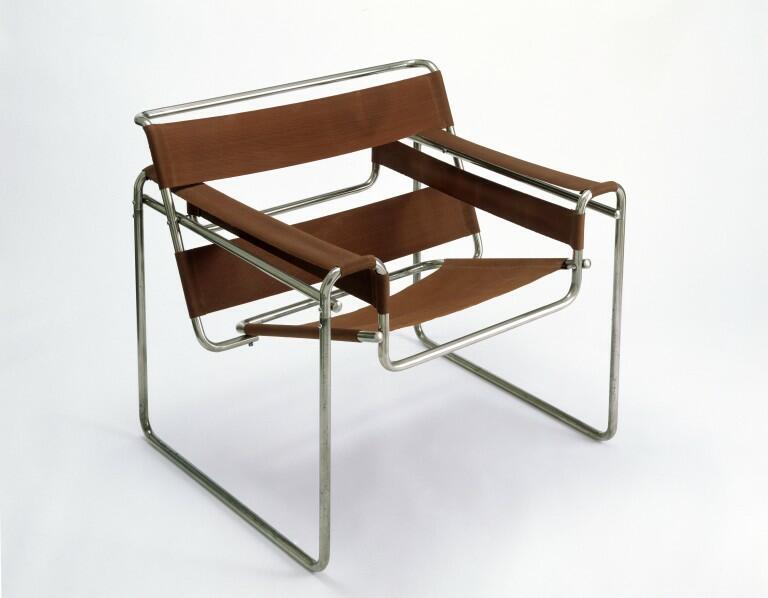

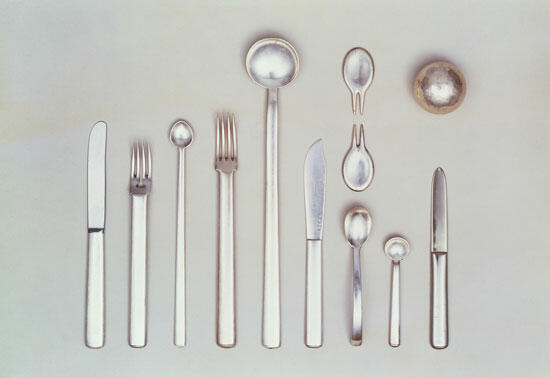
Exploring Arts and Crafts
As a contrast to the ideas and designs of the Bauhaus movement in design, it was chosen to explore the Arts and Crafts movement, which started as an opposition to the Industrial Revolution of the nineteenth century. The most distinguishing feature of the Arts & Crafts style is the use of high-quality materials and the emphasis on the utility of design items. The style got its start in the United Kingdom in the second half of the nineteenth century and later spread to the United States across the Atlantic at the end of the century, which made it possible for the movement to last up until the 1920s (Kaplan 1998). Practitioners of the movement such as Charles Francis Voysey (C.F.A. Voysey) believed that there should be a physical connection between an artist and his or her works, which suggested that Arts and Crafts heavily relied on handcraft for producing beautiful items of design.
Because the movement originated as a response to the increased use of machinery in creating pieces of design and architecture, its UK proponents were overall negative toward using innovative equipment within the creative process. However, as the style transferred overseas, its US followers were more welcoming of the idea to use technologies. As an example of the Arts and Crafts movement, the works of Francis Voysey will be further explored. C.F.A. Voysey is renowned for his design works in such spheres as architecture, furniture, and textiles. During his early work, Voysey predominantly focused on designing wallpapers and fabrics characterized as ideal examples of the Arts and Crafts style (Figure 5).
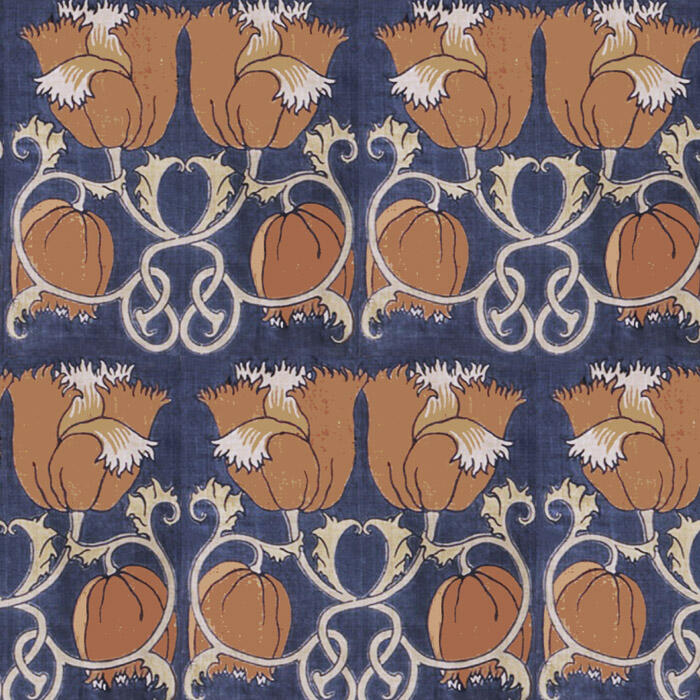
Voysey’s Design
For the sake of the analysis and comparison with modernism and Bauhaus in particular, Voysey’s architectural work will be explored. Despite the artist’s blatant opposition to modernism and the pursuit of utilitarianism, it can be suggested that his works still had the inventiveness and certain simplicity inherent in early modernism (Cole 2015). Voysey’s approach to designing houses contributed to the reputation of him as a typical English domestic residence architect. In his styles, Voysey gravitated toward stone window-dressings, slate roofs, and white-rendered houses (Figure 6). Importantly, all of his designs, including furniture (Figure 7), we’re focused on the appreciation of natural materials. Compared to modernism and Bauhaus in particular, Voysey’s architecture was simple but not simplistic and complex but not overly complicated (Simpson 1979).
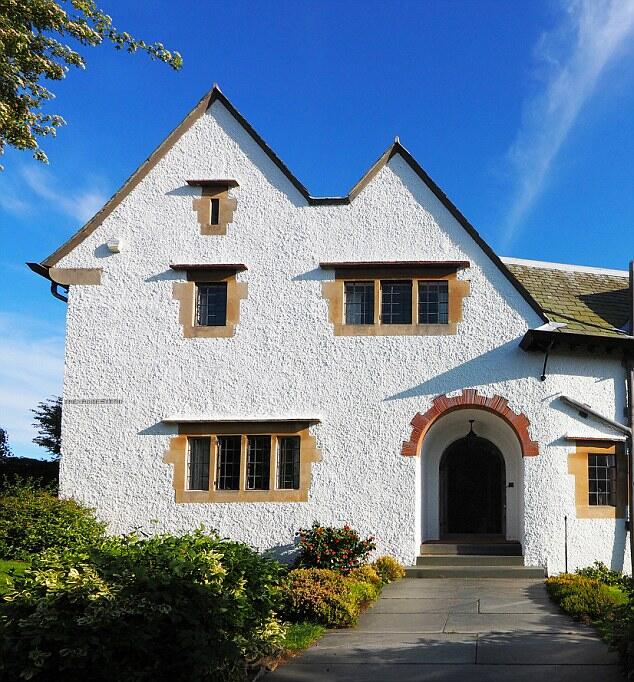
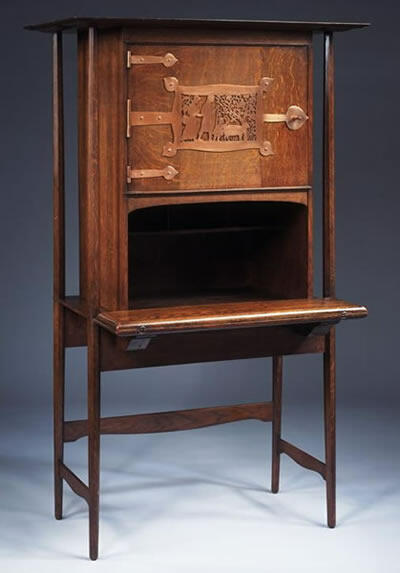
Comparing examples of Modernism and Arts and Crafts, it can be suggested that both of them have the unique quality of utilitarianism and the focus on embracing materials used in their designs. For Arts and Crafts, such materials included wood, stone, and fabrics. For modernism, they included steel, concrete, glass, and others. In addition, it should be mentioned the Arts and Crafts style came right before modernism, which suggests that there will be similarities in how both schools approached architecture and other design directions. For instance, there is distinct gravitation toward simplifying architecture in Voysey’s work while in the Bauhaus direction of modernism, the simplification reached its peak and proceeded to envelop to this day.
Conclusion
It can be concluded that the innovative approaches that both Modernism and Arts and Crafts had a tremendous impact on how current design styles came to life. For instance, some connections between Arts and Crafts and the farmhouse style of home décor, especially when it comes to preserving houses built in the late nineteenth century. Modernism still has its influence on current design approaches such as minimalism or industrial interior décor.
To summarise, Modernism as a style developed as a result of simplification in design and architecture that started with the Arts and Crafts movement. As seen from the example of the Bauhaus style, modernism focused on the use of contemporary materials associated with the process of industrialization. Because of this, the emphasis was placed on unique shapes and simplistic designs. In Arts and Crafts, the use of machinery was minimized in order to elevate the beauty of the connection between an artist and his works. This meant that natural materials were embraced while designs were more intricate and handmade-like.
Reference List
Bauhaus n.d., image, Web.
Cole, D 2015, The art of CFA Voysey: English pioneer modernist architect & designer, The Image Publishing Group, London.
Harrison, C 1997, Modernism, Cambridge University Press, Cambridge.
Josef Hoffmann’s silverware n.d., image, Web.
Kaplan, W 1998, The encyclopedia of arts and crafts, Knickerbocker Press, London.
Marcel Breuer’s Club chair (model B3)n.d., image, Web.
Saletnik, J & Schuldenfrei, R 2013, Bauhaus construct: fashioning identity, discourse and modernism, Routledge, New York, NY.
Simpson, D 1979, C.F.A. Voysey: an architect of individuality, Whitney Library of Design, New York, NY.
Sudjic, D 2014, B is for Bauhaus: an A-Z of the modern world, Penguin, London.
Voysey’s architecture n.d., image, Web.
Voysey’s fabric design n.d., image, Web.
Voysey’s secretaire n.d., image, Web.
Whitford, F 1984, Bauhaus (world or art), Thames and Hudson Ltd., London.
Wilhelm Wagenfeld’s table lamp n.d., image, Web.